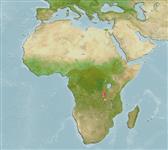Actinopterygii (ray-finned fishes) >
Clupeiformes (Herrings) >
Clupeidae (Herrings, shads, sardines, menhadens) > Dorosomatinae
Etymology: Limnothrissa: Greek, limne = swamp + Greek, thrissa, es = shad (Ref. 45335).
Environment / Climate / Range
Ecology
Freshwater; pelagic; non-migratory; depth range 20 - 40 m (Ref. 27631). Tropical; 21°C - 29°C (Ref. 5392), preferred ?; 3°S - 18°S
Africa: endemic to Lake Tanganyika (Ref. 28136), but introduced into several other lakes (Lake Kivu, Lake Kariba, and Cabora Bassa reservoir) (Ref. 188, 28136).
Length at first maturity / Size / Weight / Age
Maturity: Lm 6.8 range ? - ? cm
Max length : 17.0 cm SL male/unsexed; (Ref. 4967); common length : 10.0 cm SL male/unsexed; (Ref. 4967)
Dorsal
spines
(total): 0;
Dorsal
soft rays
(total): 13-18;
Anal
spines: 0;
Anal
soft rays: 15 - 19;
Vertebrae: 41 - 44. Body fairly slender. Pre-pelvic scutes not strongly keeled, beginning behind base of last pectoral fin ray. Maxilla blade over 4 times as long as its shaft, its lower toothed edge continued forward to meet hind tip of pre-maxilla; second supra-maxilla asymmetrical, lower half larger. Lower gill rakers long and slender. A distinct silver stripe along flank. Snout broad with tapering sides, not concave when viewed from above. It has a large air bladder which is responsible for its ability to move great vertical distances.
Near shore and in bays. Very common, has been successfully introduced to Lakes Kava, Kariba and Carbora Bass (Ref. 4967). A lacustrine species, preferring open water (Ref. 13337). Forms large schools. Mainly nocturnal and feeds on plankton (especially atyid shrimps, also copepods, prawns), but larger individuals take larval Stolothrissa. Cannibalism does occur (Ref. 13337). Breeds close to shore throughout the rainy seasons, but with peaks in May to June and December to January. Fire is used to attract the fish and caught by means of scoop nets (Ref. 36900).
Breeds close to the shore during the rainy seasons, but with peaks in May/June and December/January (Ref. 188).
Whitehead, P.J.P., 1985. FAO Species Catalogue. Vol. 7. Clupeoid fishes of the world (suborder Clupeioidei). An annotated and illustrated catalogue of the herrings, sardines, pilchards, sprats, shads, anchovies and wolf-herrings. FAO Fish. Synop. 125(7/1):1-303. Rome: FAO. (Ref. 188)
IUCN Red List Status (Ref. 115185)
CITES (Ref. 94142)
Not Evaluated
Threat to humans
Potential pest (Ref. 13055)
Human uses
Fisheries: commercial; bait: usually
Tools
Special reports
Download XML
Internet sources
